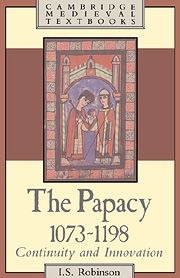Book contents
9 - The papacy and the crusade
Published online by Cambridge University Press: 05 June 2012
Summary
The crusade was a holy war which differed from earlier wars against the enemies of Christendom in that it was waged by command of the pope. The military leaders of the First Crusade acknowledged that it was Pope Urban II ‘who started this expedition, who by your sermons caused us all to leave our lands … who commanded us to take up the cross and to follow Christ’. In September 1098 the crusading princes urged the pope as ‘the father and head of the Christian religion’ to ‘bring to completion the war which is your own’ and ‘as the vicar of St Peter, take your seat in his church and receive us as your obedient sons in well doing’. Even though the papal sermon at the council of Clermont in November 1095 may have spoken of Christ as the leader of the enterprise, the papal letters of the following months assumed the leadership for Urban II himself: ‘we have made our dearest son Bishop Adhemar of Le Puy leader of this expedition and this struggle in our place, so that those who may choose to undertake this journey should obey his commands as if they were our own.’ The earliest reference to the First Crusade in a narrative source – that of Bernold of St Blasien in his chronicle – states that ‘the lord pope was the principal author of this expedition’; and this theme recurs in the crusading histories of the early twelfth century.
- Type
- Chapter
- Information
- The Papacy, 1073–1198Continuity and Innovation, pp. 322 - 366Publisher: Cambridge University PressPrint publication year: 1990



